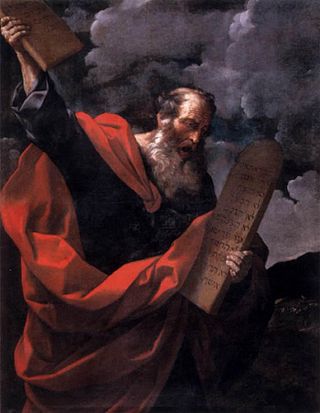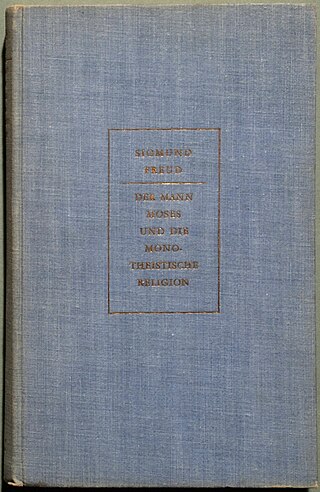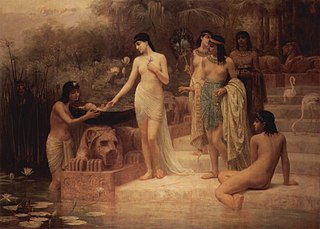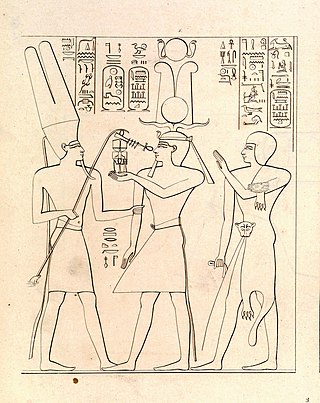Related Research Articles
In the Book of Exodus, Amram is the husband of Jochebed and father of Aaron, Moses and Miriam.
The Book of Exodus is the second book of the Bible. It is a narrative of the Exodus, the origin myth of the Israelites leaving slavery in Biblical Egypt through the strength of their deity named Yahweh, who according to the story chose them as his people. The Israelites then journey with the legendary prophet Moses to Mount Sinai, where Yahweh gives the 10 commandments and they enter into a covenant with Yahweh, who promises to make them a "holy nation, and a kingdom of priests" on condition of their faithfulness. He gives them their laws and instructions to build the Tabernacle, the means by which he will come from heaven and dwell with them and lead them in a holy war to conquer Canaan, which has earlier, according to the myth of Genesis, been promised to the "seed" of Abraham, the legendary patriarch of the Israelites.

The history of ancient Israel and Judah spans from the early appearance of the Israelites in Canaan's hill country during the late second millenium BCE, to the establishment and subsequent downfall of the two Israelite kingdoms in the mid-first millenium BCE. This history unfolds within the Southern Levant during the Iron Age. The earliest documented mention of "Israel" as a people appears on the Merneptah Stele, an ancient Egyptian inscription dating back to around 1208 BCE. Archaeological evidence suggests that ancient Israelite culture evolved from the pre-existing Canaanite civilization. During the Iron Age II period, two Israelite kingdoms emerged in the region: the Kingdom of Israel in the north and the Kingdom of Judah in the south.

Moses was a Hebrew teacher and leader considered the most important prophet in Judaism and one of the most important prophets in Christianity, Islam, the Baháʼí Faith, and other Abrahamic religions. According to both the Bible and the Quran, Moses was the leader of the Israelites and lawgiver to whom the prophetic authorship of the Torah is attributed.

Yahweh was an ancient Levantine deity, and national god of the Israelite kingdoms of Israel and Judah. Though no consensus exists regarding the deity's origins, scholars generally contend that Yahweh is associated with Seir, Edom, Paran and Teman, and later with Canaan. The origins of his worship reach at least to the early Iron Age, and likely to the Late Bronze Age, if not somewhat earlier.
In the biblical Books of Kings, the Nehushtan is the bronze image of a serpent on a pole. The image is described in the Book of Numbers, where Yahweh instructed Moses to erect it so that the Israelites who saw it would be cured and be protected from dying from the bites of the "fiery serpents", which Yahweh had sent to punish them for speaking against Him and Moses.
Monolatry is the belief in the existence of many gods, but with the consistent worship of only one deity. The term monolatry was perhaps first used by Julius Wellhausen.

Miriam is described in the Hebrew Bible as the daughter of Amram and Jochebed, and the older sister of Moses and Aaron. She was a prophetess and first appears in the Book of Exodus.
According to the Bible, Gershom was the firstborn son of Moses and Zipporah. The name means "a stranger there" in Hebrew,, which the text argues was a reference to Moses' flight from Egypt. Biblical scholars regard the name as being essentially the same as Gershon and in the Book of Chronicles the progenitor of one of the principal Levite clans is sometimes identified as Gershom, sometimes as Gershon.

According to the Bible, Jochebed was a daughter of Levi and mother of Miriam, Aaron and Moses. She was the wife of Amram, as well as his aunt. No details are given concerning her life. According to Jewish legend, she is buried in the Tomb of the Matriarchs, in Tiberias. In the New Testament, she is praised for her faith in God.

The burning bush refers to an event recorded in the Jewish Torah. It is described in the third chapter of the Book of Exodus as having occurred on Mount Horeb. According to the biblical account, the bush was on fire but was not consumed by the flames, hence the name. In the biblical narrative, the burning bush is the location at which Moses was appointed by Yahweh to lead the Israelites out of Egypt and into Canaan.

According to the Bible and the Quran, the golden calf was a cult image made by the Israelites when Moses went up to Mount Sinai. In Hebrew, the incident is known as "the sin of the calf". It is first mentioned in the Book of Exodus.

The Exodus is the founding myth of the Israelites whose narrative is spread over four of the five books of the Pentateuch.
High places or high places are simple hilltop installations with instruments of religion: platforms, altars, standing stones, and cairns are common. Along with open courtyard shrines and sacred trees or groves, they were some of the most often-seen public places of piety in the ancient Near East. They appear in the early Bronze Age at the latest.

The Bible Unearthed: Archaeology's New Vision of Ancient Israel and the Origin of Its Sacred Texts, a book by Israel Finkelstein, Professor of Archaeology at Tel Aviv University, and Neil Asher Silberman, an archaeologist, historian and contributing editor to Archaeology Magazine published in January 2001 by Simon & Schuster using its Free Press imprint and reprinted in June 2002 using its Touchstone imprint, discusses the archaeology of Israel and its relationship to the origins and content of the Hebrew Bible.
Massah and Meribah are place names found in the Hebrew Bible. The Israelites are said to have travelled through Massah and Meribah during the Exodus, although the continuous list of visited stations in Numbers 33 does not mention this. In Exodus 17:7, Meribah is mentioned at the same time as Massah, in a context which suggests that Massah is the same location as Meribah, but other biblical mentions of Massah and Meribah, such as that in the Blessing of Moses seem to imply that they are distinct. Massah and Meribah are also referred to in several other places in the Bible.

Moses and Monotheism is a 1939 book about the origins of monotheism written by Sigmund Freud, the founder of psychoanalysis. It is Freud's final original work and it was completed in the summer of 1939 when Freud was, effectively speaking, already "writing from his death-bed." It appeared in English translation the same year.

Shemot, Shemoth, or Shemos is the thirteenth weekly Torah portion in the annual Jewish cycle of Torah reading and the first in the Book of Exodus. It constitutes Exodus 1:1–6:1. The parashah tells of the Israelites' affliction in Egypt, the hiding and rescuing of the infant Moses, Moses in Midian, the calling of Moses, circumcision on the way, meeting the elders, and Moses before Pharaoh.

The Bible makes reference to various pharaohs of Egypt. These include unnamed pharaohs in events described in the Torah, as well as several later named pharaohs, some of whom were historical or can be identified with historical pharaohs.
The Exodus is the founding myth of the Israelites. The scholarly consensus is that the Exodus, as described in the Torah, is not historical, even though there may be a historical core behind the Biblical narrative.
References
- ↑ Sandra S. Barnes, Who's Who in Religion (Marquis Who's Who, 1992), p. 170.
- ↑ Barnes, Who's Who in Religion, p. 170.
- ↑ "UC San Diego News Release" (PDF).
- ↑ "UC San Diego Registrar".
- 1 2 "University of Georgia Directory".
- ↑ "ACLS Fellows Page".
- ↑ Friedman, Richard Elliott (1997). Who Wrote the Bible? (2nd ed.). New York: HarperCollins. p. 210. ISBN 0-06-063035-3.
- ↑ Friedman, Richard E. (2017). The Exodus: How It Happened and Why It Matters. HarperOne.
- ↑ Friedman, Richard Elliott (11 September 2018). The Exodus: How It Happened and Why It Matters. HarperCollins. ISBN 978-0062565259.